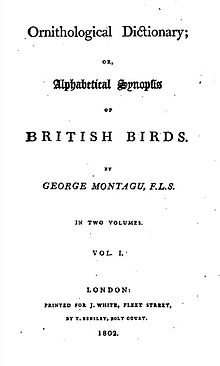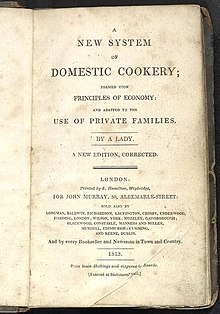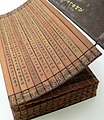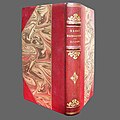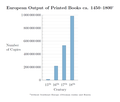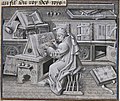Portal:Books
The Books Portal
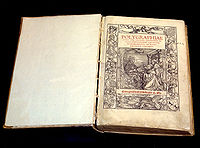
A book is a medium for recording information in the form of writing or images. Books are typically composed of many pages, bound together and protected by a cover. Modern bound books were preceded by many other written mediums, such as the codex and the scroll. The book publishing process is the series of steps involved in their creation and dissemination.
As a conceptual object, a book typically refers to a written work of substantial length, which may be distributed either physically or in digital forms like ebooks. These works are broadly classified into fiction (containing imaginary content) and non-fiction (containing content representing truths). Many smaller categories exist within these, such as children's literature meant to match the reading level and interests of children, or reference works that gather collections of non-fiction. Books are traded at both regular stores and specialized bookstores, and people can borrow them from libraries. The reception of books has led to a number of social consequences, including censorship.
A physical book does not need to contain written works: for example, it may contain only drawings, engravings, photographs, puzzles, or removable content like paper dolls. Physical books may be left empty to be used for writing or drawing, such as account books, appointment books, autograph books, notebooks, diaries and sketchbooks.
The contemporary book industry has seen several major changes due to new technologies. In some markets, the sale of printed books has decreased due to the increased use of eBooks. However, printed books still largely outsell eBooks, and many people have a preference for print. The 21st century has also seen a rapid rise in the popularity of audiobooks, which are recordings of books being read aloud. Additionally, awareness of the needs of people who can't access print media due to limitations like visual impairment has led to a rise in formats designed for greater accessibility, such as braille printing or formats supporting text-to-voice. Google Books estimated that as of 2010, approximately 130,000,000 unique books had been published. (Full article...)
Featured articles -
-
The Heart of a Woman (1981) is an autobiography by American writer Maya Angelou. The book is the fourth installment in Angelou's series of seven autobiographies. The Heart of a Woman recounts events in Angelou's life between 1957 and 1962 and follows her travels to California, New York City, Cairo, and Ghana as she raises her teenage son, becomes a published author, becomes active in the civil rights movement, and becomes romantically involved with a South African anti-apartheid fighter. One of the most important themes of The Heart of a Woman is motherhood, as Angelou continues to raise her son. The book ends with her son leaving for college and Angelou looking forward to newfound independence and freedom.
Like Angelou's previous volumes, the book has been described as autobiographical fiction, though most critics, as well as Angelou, have characterized it as autobiography. Although most critics consider Angelou's first autobiography I Know Why the Caged Bird Sings more favorably, The Heart of a Woman has received positive reviews. It was chosen as an Oprah's Book Club selection in 1997. (Full article...) -
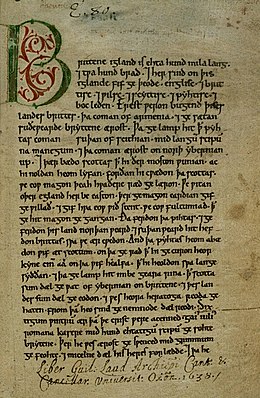
The initial page of the Peterborough Chronicle
The Anglo-Saxon Chronicle is a collection of annals in Old English, chronicling the history of the Anglo-Saxons.
The original manuscript of the Chronicle was created late in the ninth century, probably in Wessex, during the reign of Alfred the Great (r. 871–899). Its content, which incorporated sources now otherwise lost dating from as early as the seventh century, is known as the "Common Stock" of the Chronicle. Multiple copies were made of that one original and then distributed to monasteries across England, where they were updated, partly independently. These manuscripts collectively are known as the Anglo-Saxon Chronicle. Almost all of the material in the Chronicle is in the form of annals, by year; the earliest is dated at 60 BC (the annals' date for Caesar's invasions of Britain). In one case, the Chronicle was still being actively updated in 1154. (Full article...) -
David Suzuki: The Autobiography is the 2006 autobiography of Canadian science writer and broadcaster David Suzuki. The book focuses mostly on his life since the 1987 publication of his first autobiography, Metamorphosis: Stages in a Life. It begins with a chronological account of his childhood, academic years, and broadcasting career. In later chapters, Suzuki adopts a memoir style, writing about themes such as his relationship with Australia, his experiences in Brazil and Papua New Guinea, the founding of the David Suzuki Foundation, and his thoughts on climate change, celebrity status, technology, and death. Throughout, Suzuki highlights the continuing impact of events from his childhood.
This is Suzuki's forty-third book and, he says, his last. Critics have called the book candid, sincere, and charming, with insightful commentary if occasionally flat stories. Suzuki's scientific background is reflected in the writing's rational and analytic style. (Full article...) -
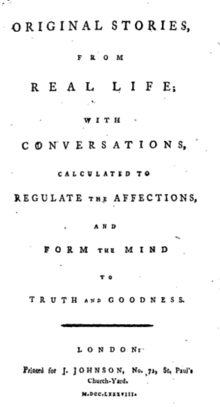
Title page from the first edition of Original Stories (1788)
Original Stories from Real Life; with Conversations Calculated to Regulate the Affections, and Form the Mind to Truth and Goodness is the only complete work of children's literature by the 18th-century English feminist author Mary Wollstonecraft. Original Stories begins with a frame story that sketches out the education of two young girls by their maternal teacher Mrs. Mason, followed by a series of didactic tales. The book was first published by Joseph Johnson in 1788; a second, illustrated edition, with engravings by William Blake, was released in 1791 and remained in print for around a quarter of a century.
In Original Stories, Wollstonecraft employed the then-burgeoning genre of children's literature to promote the education of women and an emerging middle-class ideology. She argued that women would be able to become rational adults if they were educated properly as children, which was not a widely held belief in the 18th century, and contended that the nascent middle-class ethos was superior to the court culture represented by fairy tales and to the values of chance and luck found in chapbook stories for the poor. Wollstonecraft, in developing her own pedagogy, also responded to the works of the two most important educational theorists of the 18th century: John Locke and Jean-Jacques Rousseau. (Full article...) -
Night is a 1960 memoir by Elie Wiesel based on his Holocaust experiences with his father in the Nazi German concentration camps at Auschwitz and Buchenwald in 1944–1945, toward the end of the Second World War in Europe. In just over 100 pages of sparse and fragmented narrative, Wiesel writes about his loss of faith and increasing disgust with humanity, recounting his experiences from the Nazi-established ghettos in his hometown of Sighet, Romania, to his migration through multiple concentration camps. The typical parent–child relationship is inverted as his father dwindled in the camps to a helpless state while Wiesel himself became his teenaged caregiver. His father died in January 1945, taken to the crematory after deteriorating from dysentery and a beating while Wiesel lay silently on the bunk above him for fear of being beaten too. The memoir ends shortly after the United States Army liberated Buchenwald in April 1945.
After the war, Wiesel moved to Paris and in 1954 completed an 862-page manuscript in Yiddish about his experiences, published in Argentina as the 245-page Un di velt hot geshvign ("And the World Remained Silent"). The novelist François Mauriac helped him find a French publisher. Les Éditions de Minuit published 178 pages as La Nuit in 1958, and in 1960 Hill & Wang in New York published a 116-page translation as Night. (Full article...) -

Title page from the second volume of Lives of the Most Eminent Literary and Scientific Men of France (1838)
The Lives of the Most Eminent Literary and Scientific Men comprised ten volumes of Dionysius Lardner's 133-volume Cabinet Cyclopaedia (1829–1846). Aimed at the self-educating middle class, this encyclopedia was written during the 19th-century literary revolution in Britain that encouraged more people to read.
The Lives formed part of the Cabinet of Biography in the Cabinet Cyclopaedia. Within the set of ten, the three-volume Lives of the Most Eminent Literary and Scientific Men of Italy, Spain and Portugal (1835–37) and the two-volume Lives of the Most Eminent Literary and Scientific Men of France (1838–39) consist of biographies of important writers and thinkers of the 14th to 18th centuries. Most of them were written by the Romantic writer Mary Shelley. Shelley's biographies reveal her as a professional woman of letters, contracted to produce several volumes of works and paid well to do so. Her extensive knowledge of history and languages, her ability to tell a gripping biographical narrative, and her interest in the burgeoning field of feminist historiography are reflected in these works. (Full article...) -

Epiphanius of Salamis' book the Panarion is the main source of information regarding the Gospel of the Ebionites.
The Gospel of the Ebionites is the conventional name given by scholars to an apocryphal gospel extant only as seven brief quotations in a heresiology known as the Panarion, by Epiphanius of Salamis; he misidentified it as the "Hebrew" gospel, believing it to be a truncated and modified version of the Gospel of Matthew. The quotations were embedded in a polemic to point out inconsistencies in the beliefs and practices of a Jewish Christian sect known as the Ebionites relative to Nicene orthodoxy.
The surviving fragments derive from a gospel harmony of the Synoptic Gospels, composed in Greek with various expansions and abridgments reflecting the theology of the writer. Distinctive features include the absence of the virgin birth and of the genealogy of Jesus; an Adoptionist Christology, in which Jesus is chosen to be God's Son at the time of his Baptism; the abolition of the Jewish sacrifices by Jesus; and an advocacy of vegetarianism. (Full article...) -
Louis Riel is a historical biography in comics by Canadian cartoonist Chester Brown, published as a book in 2003 after serialization in 1999–2003. The story deals with Métis rebel leader Louis Riel's antagonistic relationship with the newly established Canadian government. It begins shortly before the 1869 Red River Rebellion, and ends with Riel's 1885 hanging for high treason. The book explores Riel's possible schizophrenia—he believed God had named him Prophet of the New World, destined to lead the Métis people to freedom.
The work is noted for its emotional disengagement, its intentionally flat dialogue, and a minimalist drawing style inspired by that of Harold Gray's comic strip Little Orphan Annie. Unusual for comics of the time, it includes a full scholarly apparatus: a foreword, index, bibliography, and end notes. The lengthy, hand-lettered appendix provides insight into Brown's creative process and biases and highlights where he changed historical facts to create a more engaging story, such as incorporating a conspiracy theory not widely accepted by historians. Brown became interested in the issue of property rights while researching the book, which led to a public change in his politics from anarchism to libertarianism. (Full article...) -
Hemming's Cartulary is a manuscript cartulary, or collection of charters and other land records, collected by a monk named Hemming around the time of the Norman Conquest of England. The manuscript comprises two separate cartularies that were made at different times and later bound together; it is in the British Library as MS Cotton Tiberius A xiii. The first was composed at the end of the 10th or beginning of the 11th century. The second section was compiled by Hemming and was written around the end of the 11th or the beginning of the 12th century. The first section, traditionally titled the Liber Wigorniensis, is a collection of Anglo-Saxon charters and other land records, most of which are organized geographically. The second section, Hemming's Cartulary proper, combines charters and other land records with a narrative of deprivation of property owned by the church of Worcester.
The two works are bound together in one surviving manuscript, the earliest surviving cartulary from medieval England. A major theme is the losses suffered by Worcester at the hands of royal officials and local landowners. Included amongst the despoilers are kings such as Cnut and William the Conqueror, and nobles such as Eadric Streona and Urse d'Abetot. Also included are accounts of lawsuits waged by the Worcester monks in an effort to regain their lost lands. The two sections of the cartulary were first printed in 1723. The original manuscript was slightly damaged by fire in 1733, and required rebinding. (Full article...) -
The Log from the Sea of Cortez is an English-language book written by American author John Steinbeck and published in 1951. It details a six-week (March 11 – April 20) marine specimen-collecting boat expedition he made in 1940 at various sites in the Gulf of California (also known as the Sea of Cortez), with his friend, the marine biologist Ed Ricketts. It is regarded as one of Steinbeck's most important works of non-fiction chiefly because of the involvement of Ricketts, who shaped Steinbeck's thinking and provided the prototype for many of the pivotal characters in his fiction, and the insights it gives into the philosophies of the two men.
The Log from the Sea of Cortez is the narrative portion of an earlier work, Sea of Cortez: A Leisurely Journal of Travel and Research, which was published by Steinbeck and Ricketts shortly after their return from the Gulf of California, and combined the journals of the collecting expedition, reworked by Steinbeck, with Ricketts' species catalogue. After Ricketts' death in 1948, Steinbeck dropped the species catalogue from the earlier work and republished it with a eulogy to his friend added as a foreword. (Full article...) -
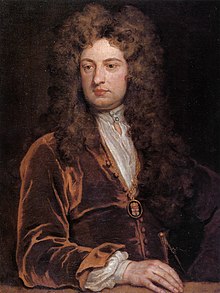
John Vanbrugh (1664–1726), author of The Relapse, by Godfrey Kneller
The Relapse, or, Virtue in Danger is a Restoration comedy from 1696 written by John Vanbrugh. The play is a sequel to Colley Cibber's Love's Last Shift, or, The Fool in Fashion.
In Cibber's Love's Last Shift, a free-living Restoration rake is brought to repentance and reform by the ruses of his wife, while in The Relapse, the rake succumbs again to temptation and has a new love affair. His virtuous wife is also subjected to a determined seduction attempt, and resists with difficulty. (Full article...) -
Political Animals and Animal Politics is a 2014 edited collection published by Palgrave Macmillan and edited by the green political theorists Marcel Wissenburg and David Schlosberg. The work addresses the emergence of academic animal ethics informed by political philosophy as opposed to moral philosophy. It was the first edited collection to be published on the topic, and the first book-length attempt to explore the breadth and boundaries of the literature. As well as a substantial introduction by the editors, it features ten sole-authored chapters split over three parts, respectively concerning institutional change for animals, the relationship between animal ethics and ecologism, and real-world laws made for the benefit of animals. The book's contributors were Wissenburg, Schlosberg, Manuel Arias-Maldonado, Chad Flanders, Christie Smith, Clemens Driessen, Simon Otjes, Kurtis Boyer, Per-Anders Svärd, and Mihnea Tanasescu. The focus of their individual chapters varies, but recurring features include discussions of human exceptionalism, exploration of ways that animal issues are or could be present in political discourse, and reflections on the relationship between theory and practice in politics.
In part, Political Animals and Animal Politics arose from a workshop that Wissenburg and Schlosberg organised at the 2012 European Consortium for Political Research Joint Sessions conference, though not all attendees contributed to the volume and not all contributors presented at the workshop. Footage of the workshop appeared in De Haas in de Marathon (The Pacer in the Marathon), a 2012 documentary about the Dutch Party for the Animals. Political Animals and Animal Politics was published as part of the Palgrave Macmillan Animal Ethics Series, edited by Andrew Linzey and Priscilla Cohn. (Full article...) -
Boenga Roos dari Tjikembang ([buˈŋa ˈrus daˈri tʃiˈkəmbaŋ]; translated to English as The Rose of Cikembang) is a 1927 vernacular Malay-language novel written by Kwee Tek Hoay. The seventeen-chapter book follows a plantation manager, Aij Tjeng, who must leave his beloved njai (concubine) Marsiti so that he can be married. Eighteen years later, after Aij Tjeng's daughter Lily dies, her fiancé Bian Koen discovers that Marsiti had a daughter with Aij Tjeng, Roosminah, who greatly resembles Lily. In the end Bian Koen and Roosminah are married.
Inspired by the lyrics to the song "If Those Lips Could Only Speak" and William Shakespeare's A Midsummer Night's Dream, Boenga Roos dari Tjikembang was initially written as an outline for the stage drama troupe Union Dalia. Kwee intermixed several languages other than Malay, particularly Dutch, Sundanese, and English; he included two quotes from English poems and another from an English song. The novel has been interpreted variously as a promotion of theosophy, a treatise on the Buddhist concept of reincarnation, a call for education, an ode to njais, and a condemnation of how such women are treated. (Full article...) -
The Liber Eliensis is a 12th-century English chronicle and history, written in Latin. Composed in three books, it was written at Ely Abbey on the island of Ely in the fenlands of eastern Cambridgeshire. Ely Abbey became the cathedral of a newly formed bishopric in 1109. Traditionally the author of the anonymous work has been given as Richard or Thomas, two monks at Ely, one of whom, Richard, has been identified with an official of the monastery, but some historians hold that neither Richard nor Thomas was the author.
The Liber covers the period from the founding of the abbey in 673 until the middle of the 12th century, building on earlier historical works. It incorporates documents and stories of saints' lives. The work typifies a type of local history produced during the latter part of the 12th century. Similar books were written at other English monasteries. The longest of the contemporary local histories, the Liber chronicles the devastation that the Anarchy caused during the reign of King Stephen. It also documents the career of Nigel, the Bishop of Ely from 1133 to 1169, and his disputes with King Stephen. Other themes include the miracles worked by the monastery's patron saint, Æthelthryth, and gifts of land to Ely. (Full article...) -
A History of the Birds of Europe, Including all the Species Inhabiting the Western Palearctic Region is a nine-volume ornithological book published in parts between 1871 and 1896. It was mainly written by Henry Eeles Dresser, although Richard Bowdler Sharpe co-authored the earlier volumes. It describes all the bird species reliably recorded in the wild in Europe and adjacent geographical areas with similar fauna, giving their worldwide distribution, variations in appearance and migratory movements.
The pioneering ornithological work of John Ray and Francis Willughby in the seventeenth century had introduced an effective classification system based on anatomical features, and a dichotomous key to help readers identify birds. This was followed by other English-language ornithologies, notably John Gould's five-volume Birds of Europe published between 1832 and 1837. Sharpe, then librarian of the Zoological Society of London, had worked closely with Gould and wanted to expand on his work by including all species reliably recorded in Europe, North Africa, parts of the Middle East and the Atlantic archipelagos of Madeira, the Canary Islands and the Azores. He lacked the resources to undertake this task on his own, so he proposed to Dresser that they work together on this encyclopaedia, using Dresser's extensive collection of birds and their eggs and network of contacts. (Full article...)
Selected picture
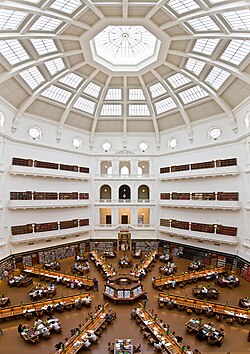
Credit: Diliff
More Did you know (auto generated)

- ... that according to the book To Kill a Democracy, when democracies destroy their social foundations, they lay the foundations for despotism?
- ... that George Griffith wrote a book about the Boer War three years before it started?
- ... that Edemariam Tsega published a book about his father while Aida Edemariam, Tsega's daughter, published a book about Tsega's mother in the same year?
- ... that a woman in Texas attempted to have Tiger Flowers removed from the library collection at her daughter's school?
- ... that the book The Icepick Surgeon discusses research by Henry Murray in which he verbally abused volunteers, one of whom went on to become the Unabomber?
- ... that a teacher of medieval literature and comic books writes the blog Rex Parker Does the NYT Crossword Puzzle?
Books topics
Related portals
-
Geographia Neoteriki (Greek: Γεωγραφία Νεωτερική Modern Geography) is a geography book written in Greek by Daniel Philippidis and Grigorios Konstantas and printed in Vienna in 1791. It focused on both the physical and human geography features of the European continent and especially on Southeastern Europe, and is considered one of the most remarkable works of the modern Greek Enlightenment. The authors of the Geographia Neoteriki adopted new geographical methodologies for that time, which were primarily based on personal examination of the described areas and used as sources a number of contemporary European handbooks.
The work, written in a vernacular language, also described the contemporary social developments and expressed ideas that were considered revolutionary and anticlerical, and addressed the political and economic decay of the Ottoman Empire. Geographia Neoteriki was welcomed with enthusiasm by western intellectual circles, especially in France, but on the other hand, it was largely neglected by Greek scholars. (Full article...) -
United Kingdom Election Results is an e-book and former website written by David Boothroyd, first published in 1994. Boothroyd also wrote The History of British Political Parties, published in 2001. The website includes material about elections in the United Kingdom, including election results, resources for further information and links to relevant websites. Boothroyd used a minimalist approach for the site's design, avoiding "flashy graphics" and placing an emphasis on "authoritative unbiased information".
Boothroyd's website has been cited by several organisations and authors, including the United Nations Development Programme and the Parliament of Australia. Boothroyd's site is listed as a resource by the website of the Parliamentary Library of the Parliament of Australia, and the Gilbert + Tobin Centre of Public Law at The University of New South Wales. The Data & Information Services Center of the University of Wisconsin said that Boothroyd maintains "an emphasis on including the entire range of parties", and The University of York library said that the "site maintained by David Boothroyd provides detailed results data for all UK Parliamentary Elections since 1983". (Full article...) -
Cyber Rights: Defending Free Speech in the Digital Age is a non-fiction book about cyberlaw, written by free speech lawyer Mike Godwin. It was first published in 1998 by Times Books. It was republished in 2003 as a revised edition by The MIT Press. Godwin graduated from the University of Texas School of Law in 1990 and was the first staff counsel for the Electronic Frontier Foundation. Written with a first-person perspective, Cyber Rights offers a background in the legal issues and history pertaining to free speech on the Internet. It documents the author's experiences in defending free speech online, and puts forth the thesis that "the remedy for the abuse of free speech is more speech". Godwin emphasizes that decisions made about the expression of ideas on the Internet affect freedom of speech in other media as well, as granted by the First Amendment to the United States Constitution.
The book was received favorably by Library Journal, where it was "Recommended for anyone concerned about expression on the Internet and democratic society." Publishers Weekly noted Godwin's "unusually broad view of free speech", and criticized the author for viewing issues "filtered through rose-colored screens". The Philadelphia Inquirer highlighted Cyber Rights among "1998's Best Reading". (Full article...) -
Judith Fingeret Krug (March 15, 1940 – April 11, 2009) was an American librarian, freedom of speech proponent, and critic of censorship. Krug became director of the Office for Intellectual Freedom at the American Library Association in 1967. In 1969, she joined the Freedom to Read Foundation as its executive director. Krug co-founded Banned Books Week in 1982.
She coordinated the effort against the Communications Decency Act of 1996, which was the first attempt by the United States Congress to introduce a form of censorship of speech on the Internet. Krug strongly opposed the notion that libraries should censor the material that they provide to patrons. She supported laws and policies protecting the confidentiality of library use records. When the United States Department of Justice used the authority of the USA PATRIOT Act of 2001 to conduct searches of what once were confidential library databases, Krug raised a public outcry against this activity by the government. (Full article...) -
Bodyguard of Lies is a 1975 non-fiction book on Allied military deception operations during the World War II written by Anthony Cave Brown. His first major historical work, it derives its name from a wartime quote of Winston Churchill, and offers a narrative account of aspects of both the Allied and German intelligence operations during the war. The British and American governments resisted Brown's attempts to research the book. Many of the topics were still classified and he was denied access to British war records. The material in the book is predominantly based on oral testimony as well as some American records, declassified toward the end of Brown's research.
Critical reception has been mixed, initially more balanced, generally more negative with time. Contemporary historians, such as Charles B. MacDonald, praised the work – although some did comment on its length. Modern reviewers have identified inconsistencies or errors in the material, based on later declassified records. Also, some of Brown's personal conclusions have been questioned. (Full article...) -
Dreamtime: Concerning the Boundary between Wilderness and Civilization is an anthropological and philosophical study of the altered states of consciousness found in shamanism and European witchcraft written by German anthropologist Hans Peter Duerr. First published in 1978 by Syndikat Autoren-und Verlagsgesellschaft under the German title of Traumzeit: Über die Grenze zwischen Wildnis und Zivilisation, it was translated into English by the Hungarian-American anthropologist Felicitas Goodman and published by Basil Blackwell in 1985.
Dreamtime opens with the premise that many of those accused of witchcraft in early modern Christendom had been undergoing visionary journeys with the aid of a hallucinogenic salve which was suppressed by the Christian authorities. Duerr argues that this salve had been a part of the nocturnal visionary traditions associated with the goddess Diana, and he attempts to trace their origins back to the ancient world, before looking at goddesses associated with the wilderness and arguing that in various goddess-centred cultures, the cave represented a symbolic vagina and was used for birth rituals. (Full article...) -
Letter to My Daughter (2009) is the third book of essays by African-American writer and poet Maya Angelou. By the time it was published, Angelou had written two other books of essays, several volumes of poetry, and six autobiographies. She was recognized and highly respected as a spokesperson for black people and women, and had become "a major autobiographical voice of the time". Angelou had no daughters herself, but was inspired to write Letter as she was going through 20 years of notes and essay ideas, some of which were written for her friend Oprah Winfrey. Angelou wrote the book for the thousands of women who saw her as a mother figure, and to share the wisdom gained throughout her long life.
Letter consists of 28 short essays, which includes a few poems and a commencement address, and is dedicated to "the daughter she never had". Reviews of the book were generally positive; most reviewers recognized that the book was full of Angelou's wisdom and that it read like words of advice from a beloved grandmother or aunt. One reviewer found the book's essays both homespun and "hokey". (Full article...) -
The Ornithological Dictionary; or Alphabetical Synopsis of British Birds was written by the English naturalist and army officer George Montagu, and first published by J. White of Fleet Street, London in 1802.
It was one of the texts, along with Thomas Bewick's contemporaneous A History of British Birds (2 volumes, 1797 and 1804) that made ornithology popular in Britain, and, with the 1676 Ornithologia libri tres of Francis Willughby and John Ray, helped to make it the object of serious study. The book includes a description of the cirl bunting, discovered by Montagu in 1800 near his home in Kingsbridge, Devon. (Full article...) -
Against the Giants is an adventure module written by Gary Gygax and published by TSR in 1981 for the Dungeons & Dragons fantasy role-playing game. It combines the G series of modules previously published in 1978: Steading of the Hill Giant Chief, Glacial Rift of the Frost Giant Jarl, and Hall of the Fire Giant King. All three were produced for use with the 1st edition Advanced Dungeons & Dragons rules. In 1999, to recognize the 25th anniversary of TSR, the company released an updated version, Against the Giants: The Liberation of Geoff. Later in 1999, Wizards of the Coast published a novelization of Against the Giants by Ru Emerson.
The plot of each of the three original modules focuses on a different type of evil giant. Each can be played as a standalone adventure, or as a series. In Steading of the Hill Giant Chief, a tribe of hill giants have been raiding lands occupied by humans, and the humans hire the player characters to defeat them. Glacial Rift of the Frost Giant Jarl pits the player characters against the evil Jarl of the frost giants. Hall of the Fire Giant King concludes the series, this time against a group of fire giants. The first two modules disclose the existence of a secret force behind the giants, which in the third module is revealed to be evil drow elves. The plot involving the drow continues in four additional modules printed between 1978 and 1980. (Full article...) -
How the Snake Lost Its Legs: Curious Tales from the Frontier of Evo-Devo is a 2014 book on evolutionary developmental biology by Lewis I. Held, Jr. The title pays homage to Rudyard Kipling's Just So Stories, but the "tales" are strictly scientific, explaining how a wide range of animal features evolved, in molecular detail. The book has been admired by other biologists as both accurate and accessible. (Full article...)
-
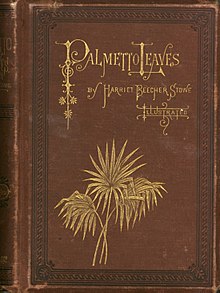
First edition cover of Palmetto Leaves
Palmetto Leaves is a memoir and travel guide written by Harriet Beecher Stowe about her winters in the town of Mandarin, Florida, published in 1873. Already famous for having written Uncle Tom's Cabin (1852), Stowe came to Florida after the U.S. Civil War (1861–1865). She purchased a plantation near Jacksonville as a place for her son to recover from the injuries he had received as a Union soldier and to make a new start in life. After visiting him, she became so enamored with the region she purchased a cottage and orange grove for herself and wintered there until 1884, even though the plantation failed within its first year. Parts of Palmetto Leaves appeared in a newspaper published by Stowe's brother, as a series of letters and essays about life in northeast Florida.
Scion of New England clergy, Stowe keenly felt a sense of Christian responsibility that was expressed in her letters. She considered it her duty to help improve the lives of newly emancipated blacks and detailed her efforts to establish a school and church in Mandarin toward these ends. Parts of the book relate the lives of local African-Americans and the customs of their society. Stowe described the charm of the region and its generally moderate climate but warned readers of "excessive" heat in the summer months and occasional cold snaps in winter. Her audience comprises relatives, friends, and strangers in New England who ask her advice about whether or not to move to Florida, which at the time was still mostly wilderness. Although it is a minor work in Stowe's oeuvre, Palmetto Leaves was one of the first travel guides written about Florida and stimulated Florida's first boom of tourism and residential development in the 1880s. (Full article...) -
The Valley Library is the primary library of Oregon State University and is located at the school's main campus in Corvallis in the U.S. state of Oregon. Established in 1887, the library was placed in its own building for the first time in 1918, what is now Kidder Hall. The current building opened in 1963 as the William Jasper Kerr Library and was expanded and renamed in 1999 as The Valley Library. The library is named for philanthropist F. Wayne Valley, who played football for Oregon State.
One of three libraries for Oregon State, The Valley Library stores more than 1.4 million volumes, 14,000 serials, and more than 500,000 maps and government documents. It is designated as a Federal Depository Library and is also a repository for state documents. The six-story library building is of a contemporary, neoclassical style with a red-brick exterior highlighted by white sections along the top and on part of the eastern side. The eastern side includes a white-faced rotunda that features a two-story atrium on the main floor. (Full article...) -
The Rage Against God (subtitle in US editions: How Atheism Led Me to Faith) is the fifth book by Peter Hitchens, first published in 2010. The book describes Hitchens's journey from atheism, far-left politics, and bohemianism to Christianity and conservatism, detailing the influences on him that led to his conversion. The book is partly intended as a response to God Is Not Great, a book written by his brother Christopher Hitchens in 2007.
Peter Hitchens, with particular reference to events which occurred in the Soviet Union, argues that his brother's verdict on religion is misguided, and that faith in God is both a safeguard against the collapse of civilisation into moral chaos and the best antidote to what he views as the dangerous idea of earthly perfection through utopianism. (Full article...) -
The Path of Modern Yoga: The History of an Embodied Spiritual Practice is a 2016 history of the modern practice of postural yoga by the yoga scholar Elliott Goldberg. It focuses in detail on eleven pioneering figures of the transformation of yoga in the 20th century, including Yogendra, Kuvalayananda, Pant Pratinidhi, Krishnamacharya, B. K. S. Iyengar and Indra Devi.
The book's thesis is that modern yoga progressed in three stages from its pre-1900 state to what is observed today. Before 1900, haṭha yoga was the despised religious practice of a small minority on the fringes of Indian society. In the first stage, pioneers such as Yogendra and Kuvalayananda treated yoga as the subject of medical inquiry, making it both secular and socially acceptable. Next, advocates of exercise brought standing poses from gymnastics into yoga: Pant Pratinidhi advocated Surya Namaskar (the sun salutation), a jumped sequence of poses, as daily exercise, while Krishnamacharya incorporated those poses and others as standing asanas in his yoga, along with the jumped transitions (vinyasas) between them, making yoga dynamic. Finally, two pupils of Krishnamacharya, Iyengar (Full article...) -
A New System of Domestic Cookery, first published in 1806 by Maria Rundell, was the most popular English cookery book of the first half of the nineteenth century; it is often referred to simply as Mrs Rundell, but its full title is A New System of Domestic Cookery: Formed Upon Principles of Economy; and Adapted to the Use of Private Families.
Mrs Rundell has been called "the original domestic goddess" and her book "a publishing sensation" and "the most famous cookery book of its time". It ran to over 67 editions; the 1865 edition had grown to 644 pages, and earned two thousand guineas. (Full article...)
Selected quote

| “ | Some books are to be tasted, others to be swallowed, and some few to be chewed and digested. | ” |
| — Francis Bacon | ||
Did you know
- ...that the Arabic translation of Borunsi sold one million copies in its first year of publication?
- ...that Albert Pick wrote the first modern catalog of banknotes in 1974 ?
General images
-
9th-century Qur'an in Reza Abbasi Museum (from Bookbinding)
-
Example of blind tooling a book binding with exquisite detail (from Bookbinding)
-
Photograph of a printing press in Egypt, c. 1922 (from History of books)
-
European output of books 500–1800 (from History of books)
-
The Codex Manesse, a German book from the Middle Ages (from History of books)
-
A traditional bookbinder at work (from Bookbinding)
-
Design by Hans Holbein the Younger for a metalwork book cover (or treasure binding) (from Book design)
-
Book conservators at the State Library of New South Wales, 1943 (from Bookbinding)
-
Rebacking saving original spine, showing one volume finished and one untouched (from Bookbinding)
-
Hardbound book spine stitching (from Bookbinding)
-
A Chinese bamboo book (from History of books)
-
Sammelband of three alchemical treatises, bound in Strasbourg by Samuel Emmel c. 1568, showing metal clasps and leather covering of boards (from Bookbinding)
-
The scene in Botticelli's Madonna of the Book (1480) reflects the presence of books in the houses of richer people in his time. (from History of books)
-
Cloth book cover with attached paper panel, mimicking half leather binding (from Bookbinding)
-
European output of manuscripts 500–1500 (from History of books)
-
Scheme of common book design(from Bookbinding)
- Belly band
- Flap
- Endpaper
- Book cover
- Head
- Fore edge
- Tail
- Right page, recto
- Left page, verso
- Gutter
-
Early medieval bookcase containing about ten codices depicted in the Codex Amiatinus (c. 700) (from Bookbinding)
-
Modern book spine designs (from Bookbinding)
-
A Sumerian clay tablet, currently housed in the Oriental Institute at the University of Chicago, inscribed with the text of the poem Inanna and Ebih by the priestess Enheduanna, the first author whose name is known
-
Hardbound book with half leather binding (spine and corners) and marbled boards (from Bookbinding)
-
Bookbinder's type holder (from Bookbinding)
-
Decorative binding with figurehead of the 12th century manuscript Liber Landavensis (from Bookbinding)
-
Page from a Jain manuscript depicting the birth of Mahavira, c. 1400 (from History of books)
-
12-metre-high (40 ft) stack of books sculpture at the Berlin Walk of Ideas, commemorating the invention of modern book printing (from History of books)
-
Folio from the Shah Jahan Album, c. 1620, depicting the Mughal Emperor Shah Jahan (from History of books)
-
Woman holding wax tablets in the form of the codex. Wall painting from Pompeii, before 79 CE. (from History of books)
-
European output of printed books c. 1450–1800 (from History of books)
-
Modern paperback spines (from Bookbinding)
-
Page spread with J. A. van de Graaf's construction of classical text area (print space) and margin proportions (from Book design)
-
Dresden Codex (page 49) (from History of books)
-
An author portrait of Jean Miélot writing his compilation of the Miracles of Our Lady, one of his many popular works. (from History of books)
-
Marbled book board from a book published in London in 1872 (from Bookbinding)
-
Folio from a manuscript of the Shanamah (Book of Kings) (from History of books)
-
Traditionally sewn book opened flat (from Bookbinding)
-
Three books with different titling orientations:
(left) ascending
(middle) descending
(right) upright (from Bookbinding) -
The Book of the Dead of Hunefer, c. 1275 BCE, ink and pigments on papyrus, in the British Museum (London) (from History of books)
-
The spine of the book is an important aspect in book design, especially in the cover design. When the books are stacked up or stored in a shelf, the details on the spine is the only visible surface that contains the information about the book. In a book store, it is often the details on the spine that attract the attention first. (from Book design)
-
A 15th-century Incunable. Notice the blind-tooled cover, corner bosses, and clasps. (from History of books)
-
Page from the Blue Quran manuscript, ca. 9th or 10th century CE (from History of books)
-
Jikji, Selected Teachings of Buddhist Sages and Seon Masters, the earliest known book printed with movable metal type, 1377. Bibliothèque Nationale de France, Paris. (from History of books)
Books lists
WikiProjects
Categories
Things you can do

- Find news articles regarding notable books and add them to the "In the news" section.
- Expand this portal and book-related articles: List of Jamaican books
- Create new articles: Lists of books provides a comprehensive list of notable books, many of which have no articles.
- Add references: List of CEO books, List of anonymously published works
- Make this portal more complete:
- Add {{WPBooks}} to the Talk pages of articles about notable books – but try to add an initial Assessment from the Wikipedia:WikiProject_Books
- Add
{{Portal|Books}}to appropriate articles within the subject
- Anything else you can think of doing.
Web resources
- Bookbinding and the Conservation of books, A Dictionary of Descriptive Terminology, 1982 by Matt T. Roberts and Don Etherington
- IOBA glossary of book terms
- Project Gutenberg - Free e-Books
- Words at Large: The best in books from CBC.ca
- please add more!
Associated Wikimedia
The following Wikimedia Foundation sister projects provide more on this subject:
-
Commons
Free media repository -
Wikibooks
Free textbooks and manuals -
Wikidata
Free knowledge base -
Wikinews
Free-content news -
Wikiquote
Collection of quotations -
Wikisource
Free-content library -
Wikispecies
Directory of species -
Wikiversity
Free learning tools -
Wikivoyage
Free travel guide -
Wiktionary
Dictionary and thesaurus











